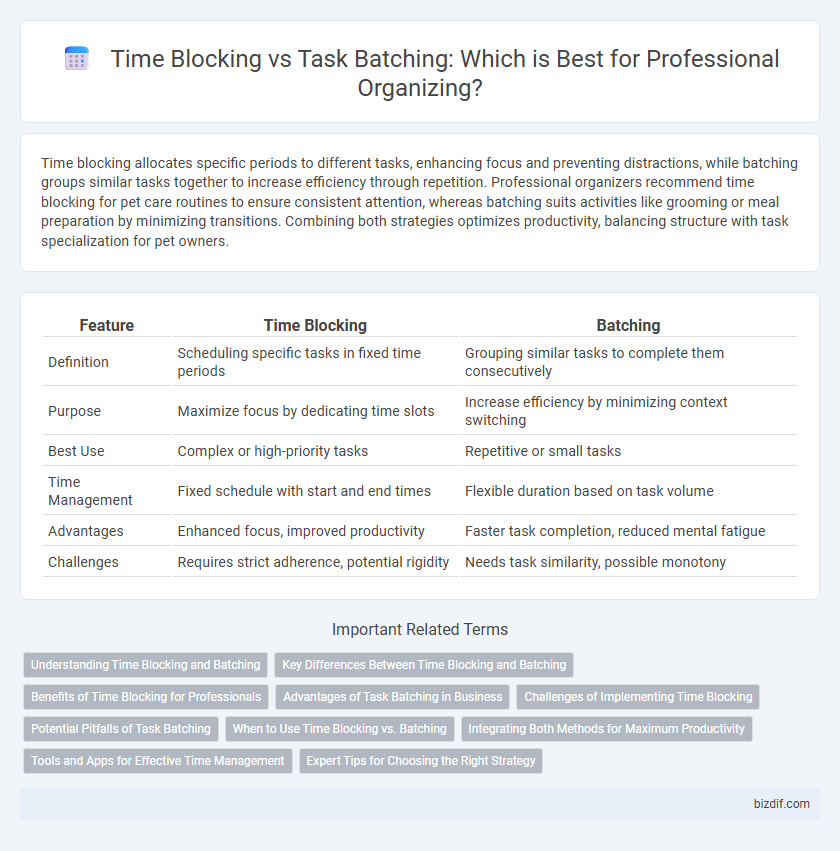Time blocking allocates specific periods to different tasks, enhancing focus and preventing distractions, while batching groups similar tasks together to increase efficiency through repetition. Professional organizers recommend time blocking for pet care routines to ensure consistent attention, whereas batching suits activities like grooming or meal preparation by minimizing transitions. Combining both strategies optimizes productivity, balancing structure with task specialization for pet owners.
Table of Comparison
| Feature | Time Blocking | Batching |
|---|---|---|
| Definition | Scheduling specific tasks in fixed time periods | Grouping similar tasks to complete them consecutively |
| Purpose | Maximize focus by dedicating time slots | Increase efficiency by minimizing context switching |
| Best Use | Complex or high-priority tasks | Repetitive or small tasks |
| Time Management | Fixed schedule with start and end times | Flexible duration based on task volume |
| Advantages | Enhanced focus, improved productivity | Faster task completion, reduced mental fatigue |
| Challenges | Requires strict adherence, potential rigidity | Needs task similarity, possible monotony |
Understanding Time Blocking and Batching
Time blocking divides your day into specific segments dedicated to individual tasks, enhancing concentration and reducing distractions. Batching groups similar tasks together to complete them more efficiently by minimizing task-switching. Understanding these strategies helps professionals optimize productivity and manage workflows effectively.
Key Differences Between Time Blocking and Batching
Time blocking allocates specific time slots for individual tasks, enhancing focus and reducing distractions throughout the day, while batching groups similar tasks to be completed consecutively, increasing efficiency by minimizing transition times. Time blocking prioritizes a structured schedule with varied activities, whereas batching optimizes workflow by handling repetitive tasks in bulk. Understanding these differences allows professionals to tailor productivity techniques based on task nature and desired outcomes in organizing work.
Benefits of Time Blocking for Professionals
Time blocking enhances productivity by allocating specific time slots for individual tasks, reducing distractions and increasing focus. This method promotes better time management, enabling professionals to prioritize high-impact activities and meet deadlines effectively. Adopting time blocking leads to improved work-life balance and reduced stress by creating structured and predictable work periods.
Advantages of Task Batching in Business
Task batching enhances productivity by grouping similar tasks together, reducing cognitive switching and minimizing distractions. This method streamlines workflow in business environments, leading to faster completion times and improved focus on complex projects. By dedicating specific periods to homogenous tasks, companies can increase efficiency and reduce burnout among employees.
Challenges of Implementing Time Blocking
Time blocking demands strict adherence to a pre-set schedule, often challenging professionals to accurately estimate task durations and resist interruptions. Overcommitting to time blocks can lead to schedule rigidity, reducing flexibility for unexpected tasks or urgent priorities. Balancing productivity with necessary breaks requires discipline, making consistent implementation difficult without effective self-regulation strategies.
Potential Pitfalls of Task Batching
Task batching can lead to decreased focus due to repetitive task fatigue, causing productivity dips during long sessions. Ignoring task complexity variations often results in underestimated time requirements and workflow bottlenecks. Lack of flexibility in rigid batch schedules may hamper responsiveness to urgent or unexpected tasks, reducing overall efficiency.
When to Use Time Blocking vs. Batching
Time blocking is ideal for tasks requiring deep focus and fixed scheduling, such as project development or client meetings, allowing precise control over daily priorities. Batching works best for repetitive, similar tasks like email processing or administrative work, reducing transition time and increasing efficiency. Use time blocking to manage high-priority, time-sensitive activities and batching to streamline routine tasks and minimize distractions.
Integrating Both Methods for Maximum Productivity
Time blocking and batching are powerful professional organizing techniques that, when integrated, optimize productivity by structuring the workday with dedicated, focused intervals. Time blocking allocates specific periods for diverse tasks or projects, while batching groups similar tasks together to minimize context switching and increase efficiency. Combining these methods allows professionals to maintain discipline over their schedules while leveraging the flow state generated by consecutive task execution, leading to enhanced time management and goal attainment.
Tools and Apps for Effective Time Management
Time blocking and batching both enhance productivity through strategic scheduling, with tools like Google Calendar and Microsoft Outlook supporting precise time block creation and reminders. Apps such as Trello and Asana facilitate task batching by grouping similar tasks for streamlined execution and progress tracking. Integrating these digital tools maximizes focus and efficiency in professional organizing by minimizing context switching and optimizing daily workflows.
Expert Tips for Choosing the Right Strategy
Time blocking allocates specific time slots to individual tasks, enhancing focus and reducing multitasking, while batching groups similar tasks together to improve efficiency and minimize transition times. Expert tips recommend evaluating the complexity and urgency of tasks to decide which method suits your workflow best, using time blocking for deep work and batching for routine or repetitive activities. Leveraging tools like digital calendars and task managers can optimize both strategies, ensuring better productivity and time management in professional organizing.
time blocking vs batching Infographic

 bizdif.com
bizdif.com